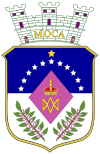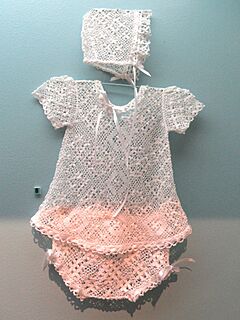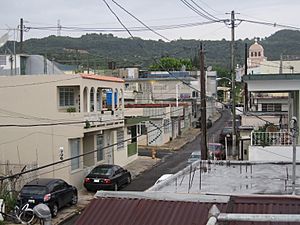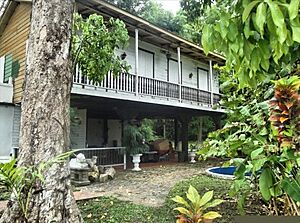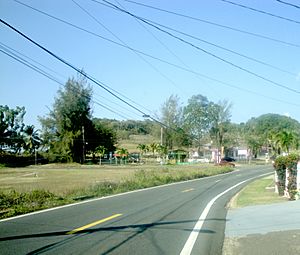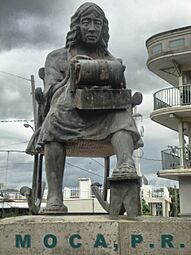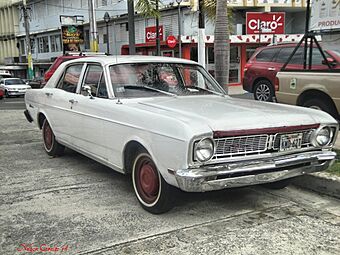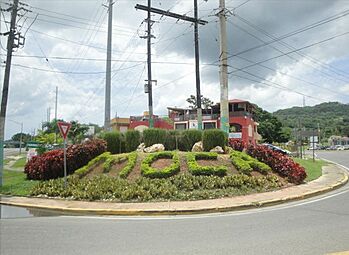Moca, Puerto Rico facts for kids
Quick facts for kids
Moca
Municipio Autónomo de Moca
|
|||
|---|---|---|---|
|
Town and Municipality
|
|||
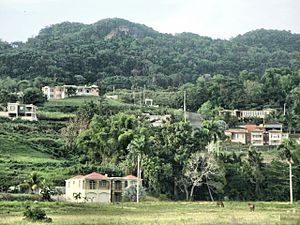
Mountains and homes in Moca
|
|||
|
|||
| Nicknames:
"Rebeldes", "Los Vampiros", "La Ciudad del Mundillo"
|
|||
| Anthem: "Doce barrios, doce estrellas" | |||

Map of Puerto Rico highlighting Moca Municipality
|
|||
| Sovereign state | |||
| Commonwealth | |||
| Founded | June 22, 1772 | ||
| Barrios | |||
| Area | |||
| • Total | 133.0 km2 (51.4 sq mi) | ||
| • Land | 133 km2 (51 sq mi) | ||
| • Water | 0 km2 (0 sq mi) | ||
| Population
(2020)
|
|||
| • Total | 37,012 | ||
| • Rank | 28th in Puerto Rico | ||
| • Density | 278.29/km2 (720.76/sq mi) | ||
| Demonym(s) | Mocanos | ||
| Time zone | UTC−4 (AST) | ||
| ZIP Code |
00676
|
||
| Area code(s) | 787/939 | ||
| Major routes | |||
Moca is a town and municipality in Puerto Rico. It is located in the northwest part of the island. Moca is north of Añasco and east of Aguada. It is also west of Isabela and San Sebastián.
The town is named after the Moca tree (Andira inermis). These trees are very common in the area. The Moca tree became the official tree of the town on February 19, 1972.
Moca is also famous for its Mundillo lace. This is a special type of handmade bobbin lace from Puerto Rico. The word Mundillo is almost like a nickname for the town of Moca itself.
Contents
History of Moca
Moca is known as La Capital del Mundillo, which means "The Mundillo Capital." It was founded by Don José de Quiñones. The exact founding date is debated, but many believe it was June 22, 1772.
In 1841, work began on the main church, called “Parroquia Nuestra Señora de la Monserrate.”
During the time when slavery was legal in Puerto Rico, Moca also had enslaved people. Records show that in 1775, there were 48 enslaved people. By 1828, this number had grown to 625. Slavery was ended in Puerto Rico on March 22, 1873.
In 1899, after the Spanish–American War, Puerto Rico became a territory of the United States. A census that year showed Moca had a population of 12,410 people.
On May 16, 2010, Moca was the center of a strong 5.8 earthquake. People felt the earthquake across the entire island. It was also felt in the Dominican Republic and the Virgin Islands. The earthquake caused damage in many towns.
On September 20, 2017, Hurricane Maria hit Puerto Rico. In Moca, the storm caused major damage. Landslides and floods from the Río Culebrinas destroyed bridges, roads, and homes. About 1300 homes were affected. Many residents lost electricity, phone service, and access to basic needs.
Geography and Climate
Moca is located in the northwest part of Puerto Rico. It is in the northern karst region, which has unique limestone landscapes.
Climate in Moca
Moca has a tropical climate. This means temperatures do not change much throughout the year. High temperatures are usually between 76 and 98 degrees Fahrenheit. Low temperatures are between 50 and 75 degrees Fahrenheit.
Rivers and Mountains
The Río Culebrinas river flows through Moca from east to west. Many smaller streams and gorges flow into it. Some of these are Los Gatos, Lassalle, and Higuillo. Moca also has mountains like Cerro Moca and Monte El Ojo. These are part of the Jaicoa Mountain Range.
Barrios of Moca
Like all municipalities in Puerto Rico, Moca is divided into smaller areas called barrios. The main town area, where the municipal buildings and the Catholic church are, is called Moca barrio-pueblo.
Population of Moca
Over the years, Moca's population has grown significantly. In 1775, there were 1,051 people. By 1868, the population had reached 10,924.
According to the U.S. Census in 2020, Moca had a total population of 37,012 residents. This was a small decrease from its population in 2010.
Economy and Jobs
Moca's economy relies on several areas:
- Agriculture: Farmers grow fruits and raise dairy cows and other cattle.
- Industrial: Factories in Moca make alarms, clothing, electronic machines, shoes, and plastic products.
- Services: Many people work in services like law and engineering.
Fun Things to See and Do
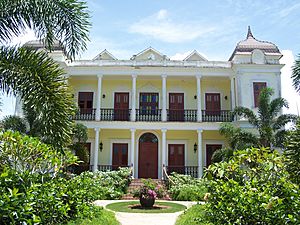
Moca has several interesting places to visit:
- Palacete Los Moreau: A beautiful mansion that is now a museum.
- Enrique Laguerre House: The home of a famous writer.
- Hacienda Enriqueta Museum: A museum that shares the history of a local farm.
- Mundillo Museum: Learn all about the famous Moca lace here.
- Our Lady of Monserrate Parish Church: The main church in the town square.
Culture and Events
Festivals
Moca celebrates its annual patron saint festival, called Fiestas Patronales Nuestra Señora de la Monserrate. This religious and cultural event usually happens in late August or early September. It features parades, games, local crafts, fun rides, traditional food, and live music.
Sports Teams
Moca has a baseball team called the Moca Vampiros. They play in the Double-A (baseball) league.
Moca also had a volleyball team called Los Rebeldes. They played from 1998 to 2005 and even won the National Championship in 2000!
The Moca Vampire Myth
Moca is famous for a local legend called El vampiro de Moca (The Moca Vampire). This story is thought to be an early version of the Chupacabra legend. The legend officially began on February 25, 1975. Newspapers reported that many farm animals were found dead with strange puncture marks and no blood.
People also reported seeing UFOs and other mysterious things around Moca at that time. Similar events were reported in other towns in Puerto Rico. The legend became popular again in the 1990s.
Transportation
Moca has 12 bridges. Like the rest of Puerto Rico, Moca used to have a public shared taxi system called Carros Públicos.
The Rafael Hernández Airport is a commercial airport located nearby in the town of Aguadilla.
Town Symbols
Moca has its own official flag and coat of arms.
Moca Flag
The flag of Moca was designed by Augusto Hernández Méndez. It is a rectangular flag with a magenta triangle. Magenta is the color of the Moca tree flower. Inside the triangle are five silver stars. These stars surround a larger gold star.
Moca Coat of Arms
The coat of arms is shaped like an oval. It has a silver background and a blue sky. These are joined by a purple diamond shape, which is the color of the Moca flower. The diamond has religious meanings. It is surrounded by two branches from the Moca tree at the bottom. Above it, there is an arch of eleven silver stars. Inside the diamond, there is a gold symbol for the Virgin Mary, topped with a gold crown. A silver crown shaped like a three-tower castle sits on top of the shield. The word Moca is carved in gold on the front of the castle.
Gallery
See also
 In Spanish: Moca (Puerto Rico) para niños
In Spanish: Moca (Puerto Rico) para niños



